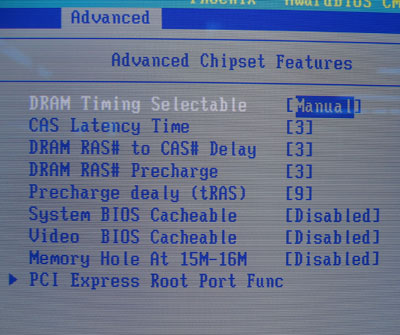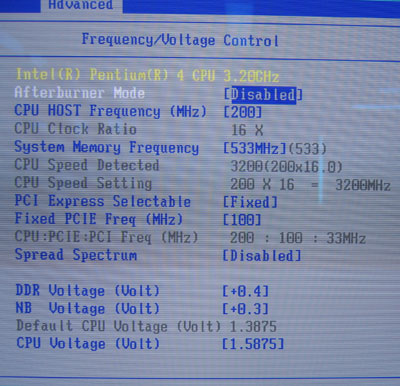 When
it comes to overclocking, Albatron has earned a good reputation, and so
our expectations where high for what the PX925XE Pro-R might
be able to achieve.
When
it comes to overclocking, Albatron has earned a good reputation, and so
our expectations where high for what the PX925XE Pro-R might
be able to achieve.
Unfortunately,
at the time of this review, a 1066FSB Intel P4EE processor was
not available for testing, so a 3.2GHz 800MHz FSB Intel
P4 chip was used.
Starting at 200 MHz FSB we slowly raised
the clock speed of the motherboard a few MHz at a time. The motherboard was
certainly up to the overclocking challenge and we didn't hit our first snag until 223 MHz.
Raising the memory voltage to 2.1V fixed the problem and
allowed us to continue.
 At 237 MHz
FSB, the motherboard started to give us occasional blue screens when booting. Raising
the 925XE voltage up 0.2V fixed those problems and we continued to push
the board further.
At 237 MHz
FSB, the motherboard started to give us occasional blue screens when booting. Raising
the 925XE voltage up 0.2V fixed those problems and we continued to push
the board further.
We ran
into more stability problems at
243 MHz, and this time we had to turn down the memory divider from 3:4 to 1:1 and
run the DDR-2 Crucial Ballistix memory in sync with the FSB. At 245 MHz, the
processor began to have some stability issues but increasing the Vcore to 1.45V fixed them.
In the end we
were able to hit 256 MHz with 100% stability. We didn't quite meet the 925XE's
standard operating frequency of 266 MHz but considering the 3.2GHz CPU was
already running at ~4.1 GHz,
I'd say the overclock went extremely well, wouldn't you?
Albatron's Powerful BIOS

In the Advanced Chipset Features section of the BIOS we have
the DDR2 memory timing adjustments: CAS Latency, RAS to CAS, RAS Precharge and
Precharge Delay (spelt wrong in the BIOS). Tweakers will be familiar with these
options.

Albatron usually has powerful and flexible
BIOS' on their motherboards and we were not disappointed with the PX925XE
Pro-R. The FSB can be adjusted from 200-300 MHz in 1 MHz increments.
Hopefully Albatron will increase this limit higher with future BIOS releases. You
can set the memory to run 1:1 or 3:4 as well as adjust the PCI Express and PCI
frequency, although those two are best left alone.
Maximum DDR2
voltage goes as high as 0.4V+, 925XE
chipset voltage ramps up 0.3V+ and the CPU 0.3V+.
 |
| PCStats Test System Specs: |
| processor: |
intel pentium 4 3.2e |
| clock
speed: |
16 x 200 mhz = 3.2 ghz |
| motherboards: |
gigabyte ga-8anxp-d (925x)*
msi 915p neo2 platinum
(915p)*
dfi lanparty 875p-t (i875p)**
asrock 775v88
(pt880)**
albatron px925xe pro-r (925xe)* |
| videocard: |
msi rx800xt-vtd256*
asus ax800xt/tvd ** |
| memory: |
2x 512mb crucial ballistix ddr2-533
2x 512mb
corsair twinx1024-3200xl |
| hard drive:
|
40gb western digital special ed |
| cdrom: |
aopen 52x combo |
| powersupply: |
seasonic super tornado 400w |
| software
setup |
windowsxp build 2600
intel inf 6.10.1012
forceware
66.85 |
| workstation
benchmarks |
sysmark 2004
business winstone 2004
content creation
2004
winbench 99
sisoft sandra 2004
super
pi
pcmark04
3dmark2001se
3dmark05
aquamark3
comanche
4
x2: the
threat
ut2003
ut2004
doom
3 | |
* - msi rx800xt videocard used ** - asus x800xt pe
videocard used
